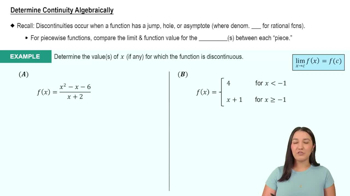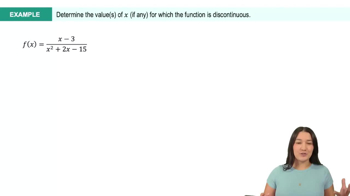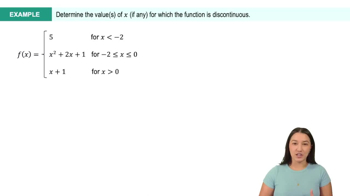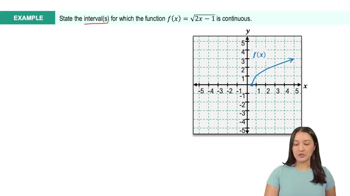Table of contents
- 0. Functions7h 52m
- Introduction to Functions16m
- Piecewise Functions10m
- Properties of Functions9m
- Common Functions1h 8m
- Transformations5m
- Combining Functions27m
- Exponent rules32m
- Exponential Functions28m
- Logarithmic Functions24m
- Properties of Logarithms34m
- Exponential & Logarithmic Equations35m
- Introduction to Trigonometric Functions38m
- Graphs of Trigonometric Functions44m
- Trigonometric Identities47m
- Inverse Trigonometric Functions48m
- 1. Limits and Continuity2h 2m
- 2. Intro to Derivatives1h 33m
- 3. Techniques of Differentiation3h 18m
- 4. Applications of Derivatives2h 38m
- 5. Graphical Applications of Derivatives6h 2m
- 6. Derivatives of Inverse, Exponential, & Logarithmic Functions2h 37m
- 7. Antiderivatives & Indefinite Integrals1h 26m
- 8. Definite Integrals4h 44m
- 9. Graphical Applications of Integrals2h 27m
- 10. Physics Applications of Integrals 2h 22m
1. Limits and Continuity
Continuity
Problem 2.8a
Textbook Question
Limits and Continuity
On what intervals are the following functions continuous?
a. ƒ(x) = tan x
 Verified step by step guidance
Verified step by step guidance1
Identify the function: The function given is \( f(x) = \tan x \). The tangent function is defined as \( \tan x = \frac{\sin x}{\cos x} \).
Determine where the function is undefined: The function \( \tan x \) is undefined where \( \cos x = 0 \) because division by zero is undefined.
Find the values of \( x \) where \( \cos x = 0 \): The cosine function is zero at odd multiples of \( \frac{\pi}{2} \), i.e., \( x = \frac{\pi}{2} + k\pi \) where \( k \) is an integer.
Identify intervals of continuity: The function \( \tan x \) is continuous on intervals where it is defined, which are the open intervals between the points where \( \cos x = 0 \).
Conclude the intervals of continuity: Therefore, \( f(x) = \tan x \) is continuous on intervals of the form \( (k\pi - \frac{\pi}{2}, k\pi + \frac{\pi}{2}) \) for each integer \( k \).
 Verified video answer for a similar problem:
Verified video answer for a similar problem:This video solution was recommended by our tutors as helpful for the problem above
Video duration:
3mPlay a video:
Was this helpful?
Key Concepts
Here are the essential concepts you must grasp in order to answer the question correctly.
Limits
Limits are fundamental in calculus, representing the value that a function approaches as the input approaches a certain point. Understanding limits is crucial for analyzing the behavior of functions, especially at points where they may not be explicitly defined. For example, the limit of tan(x) as x approaches π/2 is undefined, indicating a vertical asymptote.
Recommended video:

One-Sided Limits
Continuity
A function is continuous at a point if the limit of the function as it approaches that point equals the function's value at that point. For a function to be continuous over an interval, it must be continuous at every point within that interval. Discontinuities can occur due to vertical asymptotes, jumps, or holes in the graph, which are essential to identify when determining intervals of continuity.
Recommended video:

Intro to Continuity
The Tangent Function
The tangent function, defined as tan(x) = sin(x)/cos(x), is periodic and has vertical asymptotes where the cosine function equals zero, specifically at odd multiples of π/2. This periodicity and the locations of its discontinuities are critical for determining the intervals of continuity for tan(x). Thus, tan(x) is continuous on intervals that do not include these asymptotes.
Recommended video:
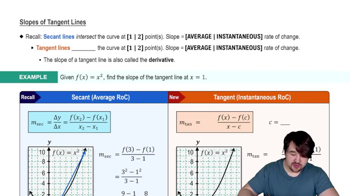
Slopes of Tangent Lines
Related Videos
Related Practice




